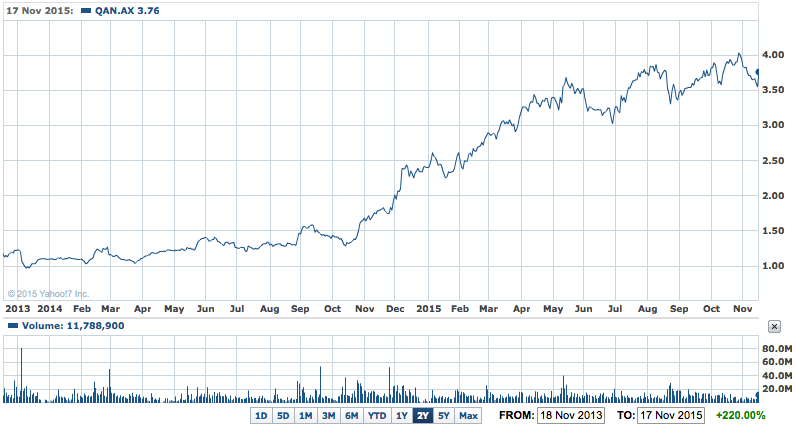Qantas (QAN) shares rose solidly yesterday after the company and ratings group Standard & Poor’s combined to produce a ratings upgrade to return the airline to the prized investment grade level.
The airline’s rating had been downgraded to “junk status” by S&P in December 2013 when it was struggling financially and sought government help to shore up its position as it battled high fuel prices and intense competition in the domestic and international markets (which had become a millstone around its profit and loss account).
The loss of the investment grade rating had increased the airline’s borrowing costs, and the carrier has repaid $1 billion of debt in the last year as it took advantage of low fuel prices and rising cash flows from improved operational efficiencies.
Qantas shares ended up nearly 6% at $3.76.
QAN 2Y – Qantas back to investment-grade

S&P’s raised Qantas’ rating to BBB-minus with a stable outlook (the second lowest level of investment grade rating) after Qantas CEO Alan Joyce committed the airline to maintaining a ratio of funds from operations to debt of more than 45% “throughout the cycle”. His commitment was made in a presentation to the UBS Australasian Conference.
Rival Moody’s has rated Qantas’s debt at Ba1 with a "positive" outlook, the highest available non-investment grade rating. Analysts expect Moody’s to return Qantas to the lowest rung of its investment ranking shortly as a result of Mr Joyce’s speech yesterday.
Only six other airlines globally have investment grade credit corporate ratings, including Air New Zealand, Lufthansa (under pressure from a continuing strike), Southwest Airlines and Alaska Airlines (in the US), Ryanair (Ireland and Europe) and WestJet (Canadian low cost operator), although some state-backed carriers like Etihad Airways (Middle East) issue investment grade debt.
In his presentation, Mr Joyce made clear the airline intends retaining a strong balance sheet, with short-term liquidity of cash and revolving credit facilities to remain above $2 billion.
S&P said the revised rating would not preclude Qantas from making “sizeable shareholder returns", adding it assumed it would return more to investors this financial year than the $505 million distribution made last year.
"However, Qantas has not committed to regular dividends and will only distribute surplus capital once it exceeds its optimal capital structure," the ratings agency said. "The revised financial framework implies that Qantas’s optimal capital structure will shift much more quickly to protect creditors if fundamentals have weakened."
Mr Joyce said there was a positive outlook for its domestic and international divisions. He forecast the domestic market should return to average growth of 3% a year from financial years 2016-2020.
In the international market, Mr Joyce said the airline would shift some of its capacity growth from the US to Asia.
The airline expects to improve its return on invested capital and earnings before interest and tax in the international division this year, having reported a $267 million underlying EBIT lin 2014-15.













